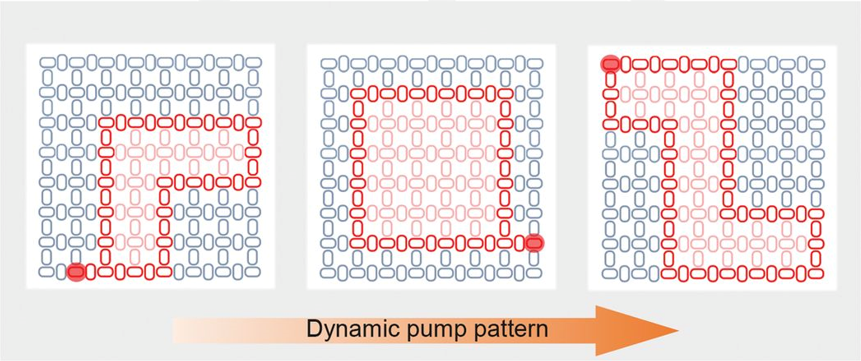Orbital Angular Momentum and Related Applications

The creation of eigenstate degeneracies such as quantum exceptional points intrinsically associated with non-Hermitian Hamiltonians, by which we have produced the world’s first on-chip orbital angular momentum microlaser (Science 2016). The creation of the quantum exceptional point in the realm of optics and photonics breaks the natural symmetry between reciprocal counterpropagating resonant modes in a micro-cavity to conduct unidirectional light-matter interaction carrying the large orbital angular momentum for structured light emission. Such a symmetry-driven approach allowed us to deliver the first microlaser source carrying the desired spin and orbital chirality as unique information carriers, giving rise to a new dimension of storing and processing information in photon’s chiral degree of freedom.
Key publications:
- Pei Miao, Zhifeng Zhang, Jingbo Sun, Wiktor Walasik, Stefano Longhi, Natalia M. Litchinitser and Liang Feng, Orbital angular momentum microlaser, Science 353, 464-467 (2016).
- Zhifeng Zhang, Xingdu Qiao, Bikashkali Midya, Kevin Liu, Jingbo Sun, Tianwei Wu, Wenjing Liu, Ritesh Agarwal, Josep Miquel Jornet, Stefano Longhi, Natalia M. Litchinitser and Liang Feng, Tunable topological charge vortex microlaser, Science 368, 760-763 (2020).
- Zhifeng Zhang, Haoqi Zhao, Shuang Wu, Tianwei Wu, Xingdu Qiao, Zihe Gao, Ritesh Agarwal, Stefano Longhi, Natalia M. Litchinitser, Li Ge and Liang Feng, Spin–orbit microlaser emitting in a four-dimensional Hilbert space, Nature 612, 246-251 (2022).
Non-Hermitian and Topological Photonics

Flexible reconfiguration of topological pathways can offer a completely new paradigm for high-density photonics routing. However, the desired topological robustness unfortunately diminishes the hope of topological tunability. To overcome this fundamental limitation, we have recently performed a perfect synergy between non-Hermitian symmetry and topological physics to enable, for the first time, a reconfigurable photonic topological insulator with a new kind of non-Hermitian topological states that travel into the bulk of the topological insulator with a uniform topology (Science 2019). Without “battling” against topological protection, the new non-Hermitian topological states facilitate robust transmission links in the entire footprint to route optical signal to any desired output port. The ports-to-footprint ratio is at least 2-3 orders of magnitude higher than the state-of-the-art.
Key Publications:
- Liang Feng, Ramy El-Ganainy and Li Ge, Non-Hermitian photonics based on parity–time symmetry, Nature Photonics 11, 752-762 (2017) (Invited Review).
- Han Zhao, Pei Miao, Mohammad H. Teimourpour, Simon Malzard, Ramy El-Ganainy, Henning Schomerus and Liang Feng, Topological hybrid silicon microlasers, Nature Communications 9, 981 (2018).
- Han Zhao, Xingdu Qiao, Tianwei Wu, Bikashkali Midya, Stefano Longhi and Liang Feng, Non-Hermitian topological light steering, Science 365, 1163-1166 (2019).
SUSY Optics
Single-mode high power laser has always been researchers’ pursuit. One seemingly straightforward method to achieve this is to couple multiple identical single-mode lasers together to form a laser array. Intuitively, this laser array would have an enhanced emission power due to the increasing number of lasing elements. However, because of the nature of a coupled system, this laser array now supports multiple transverse supermodes.
Inspired by the concept of supersymmetry (SUSY) from physics, people have proposed a scheme to enforce single mode lasing in a laser array by adding a dissipative “superpartner”. The superpartner is generated by applying SUSY transformation on the laser array, and the resulting superpartner array automatically has all the energy levels except for the fundamental one. This kind of energy level correspondence is the essence of SUSY. When the lossy SUSY partner array and the original laser array are coupled together, all the supermodes except for the fundamental mode will be dissipated, single fundamental mode lasing can therefore be achieved from the device.
Our 2D SUSY scheme provides a generic method to obtain single-mode high power lasing from evanescently coupled laser arrays, which is highly demanded and actively pursued for a wide range of applications, including optical communication, optical sensing, and LIDAR ranging. Bringing the SUSY scheme to 2D constitutes a powerful toolbox for potential large-scale integrated photonic systems.
Key publications:
- Bikashkali Midya, Han Zhao, Xingdu Qiao, Pei Miao, Wiktor Walasik, Zhifeng Zhang, Natalia M. Litchinitser and Liang Feng, Supersymmetric microring laser arrays, Photonics Research 7, 363-367 (2019).
- Xingdu Qiao, Bikashkali Midya, Zihe Gao, Zhifeng Zhang, Haoqi Zhao, Tianwei Wu, Jieun Yim, Ritesh Agarwal, Natalia M. Litchinitser and Liang Feng, Higher-dimensional supersymmetric microlaser arrays, Science 372, 403-408 (2021).
- Jieun Yim, Nitish Chandra, Xilin Feng, Zihe Gao, Shuang Wu, Tianwei Wu, Haoqi Zhao, Natalia M. Litchinitser and Liang Feng, Broadband continuous supersymmetric transformation: a new paradigm for transformation optics, eLight 2, 16 (2022).
